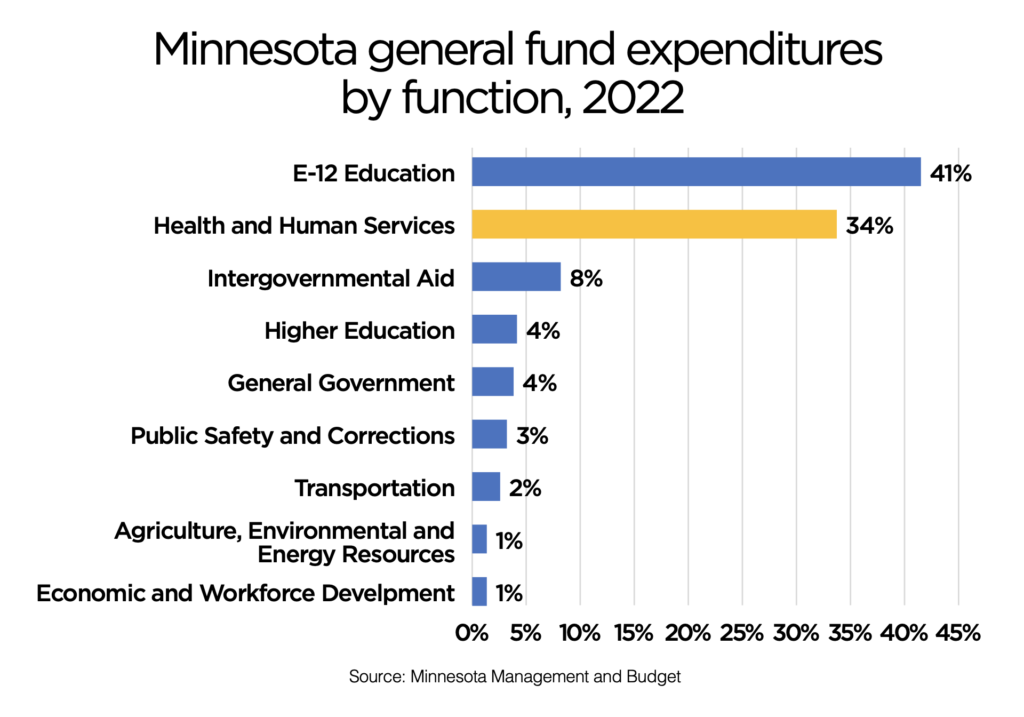The budget’s black hole
The Department of Human Services is the biggest consumer of the state’s budget — and it’s hungry for more.
In his multi-billion dollar spending proposal, Gov. Tim Walz wants to give the Department of Human Services (DHS) approximately $3 billion more in spending for the next two biennia. The majority of that spending — about two billion dollars — will take place in the 2026-27 biennium.
Walz has emphasized time and again that the $17.6 billion surplus is a chance for the state government to invest in and reduce costs for Minnesotans, especially the less fortunate. But is giving more money to DHS a good idea? Will it im- prove the lives of Minnesotans?
Likely not. DHS already consumes a large portion of the state budget and giving the agency more money would put pressure on other services. Moreover, hardships for low-income Minnesotans persist despite the fact that
our state spends significantly more than most states on public welfare programs. Spending more money is unlikely to yield positive results.
DHS already takes a huge portion of the state budget
According to Minnesota Management and Budget (MMB), in the 2022 fiscal year, the state government spent a total of $24.19 billion in general funds. Out of that, $8.13 billion — or a little over a third — went to DHS. It was the second biggest expenditure after E-12 education.
When federal funds are accounted for, DHS takes an even bigger chunk of the budget. In the 2022 fiscal year, the state government spent $47 billion when federal and other funds are accounted for. Half that amount — or $23.6 billion — went to DHS.

Not only does the DHS take a huge chunk of the state budget, but its share of the budget has also grown tremendously over time. In 2002, for example, DHS only took up eight percent of general funds and just 12 percent of all spending. But in 2022, the numbers were 34 percent and 50 percent respectively.
With endless wants but scarce resources, giving more money to DHS means there will be pressure on other, even more vital government services. This will spell trouble for the state government, especially in times of scarce government funds.
Public welfare
The U.S. Census Bureau defines public welfare as “any government spending targeted towards assistance programs for low-income individuals.” While most people associate welfare with payment checks, it is much more than that. Welfare includes big government programs like Medicaid and Medicare, as well as other programs like childcare assistance, food stamps, and housing assistance.
In the state of Minnesota, the administration of these programs falls under the DHS. For that reason, spending by DHS is synonymous with welfare spending.
How much Minnesota spends on welfare
Generally, the United States spends liberally on public welfare. In 2020, for example, a little over one fifth of all state and local government spending went to programs that the Census Bureau considers welfare. But that is not the complete picture.
The Census Bureau also records some Medicaid spending as part of health and hospitals. And in 2020, 10 percent of all state and local government spending went to that category, so it’s likely that the share of public spending is much higher.
But while only 23 percent of all national spending went to public welfare, in Minnesota the percentage was much higher. In 2020, 27 percent of all state and local government spending went to public welfare.
Not only does welfare take a bigger portion of Minnesota’s budget than the national average, but per capita spending is also significantly higher. In 2020, Minnesota spent nearly $40,000 on public welfare per person in poverty. This is double the national average and the fourth-highest in the nation.
Looking at specific programs, Minnesota has some of the country’s highest spending levels for Medicaid, even after controlling for age and disability. In 2019, Minnesota had the country’s
- Third highest Medicaid spending per enrollee (full or partial).
- Second highest Medicaid spending per senior enrollee (65 and older).
- Highest Medicaid benefit level per disabled enrollee.
- 19th and 23rd highest Medicaid spending per child and adult enrollee, respectively.
This generosity also extends to other programs such as welfare checks — or Temporary Assistance for Needy Families (TANF). Compared to the rest of the country, Minnesota has higher than average income eligibility levels, higher than average cash benefits, and also provides cash assistance to a higher proportion of people below the poverty line than the national average.
DHS does not need more money
Not only does the DHS already use a substantial portion of the Minnesota state budget, but our state already spends significantly higher on public welfare programs than does the rest of the country. By spending significantly more than most states on programs administered by the DHS — programs that come under the umbrella term “public welfare” — the agency puts pressure on other government services and could spell trouble for the state budget in times of scarce resources. Moreover, spending more money is unlikely to solve the ails being faced by less fortunate Minnesotans.